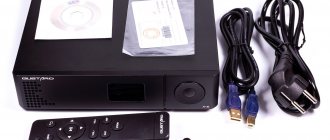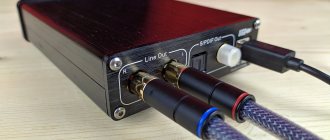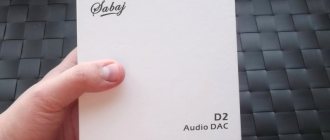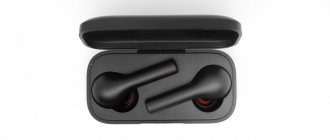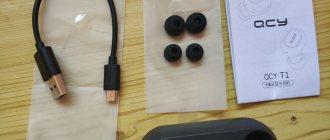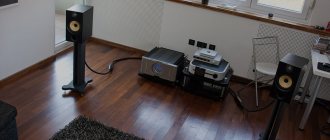To be honest, Topping DX3 Pro is probably the best DAC that I have ever listened to until today. Among the obvious advantages, there is a new dual DAC AKM AK4493EQ, XMOS of the latest generation, an excellent receiver from the same AKM, Bluetooth with support for AptX HD, and of course just an incredibly powerful amplification path for headphones, giving 1000 mW @ 32 Ohms per channel. But that’s not all, the most important thing is, of course, that same enchanting, hypnotic and at the same time detailed sound, which, as they say, “gives you goosebumps.”
INTRODUCTION
After alternately and simultaneously getting to know the Topping A90 and Gustard H16, I simply could not ignore one of the most hyped pairs among lovers of home “table” portables.
Namely, a pair, tandem, stack - whatever you want to call it - of a DAC/pre and headphone amplifier from Topping D30pro and A30pro. Being an update of the models of the same name (without the pro prefix), they essentially act as new devices made in the spirit of top solutions in the field of conversion and amplification from the Chinese. The senior amplifier A90 managed to impress your humble servant in its own way. Moreover, I tried it with all the sources that were at hand. Its key feature was “invisibility” in the path. You can simply forget about its existence over time - it is so transparent and invisible in terms of its signature. “The character is persistent, Nordic” - one could simply write about him instead of thousands of review marks. But that's not our way, right?
This characteristic is both good and bad. It eliminates the possibility of tuning and puts you under the obligation to link your source and headphones. So that the final combination sounds natural and, preferably, musical. Here, either the headphones should have a slight coloration, or the DAC should endow the sound with those features that fit into the concept of musicality and naturalness.
Looking ahead, I will say that the tandem of D30pro and A30pro managed in this regard, without breaking away from its roots, to please and show that Topping still lives not only in numbers, but also understands that the equipment is not only tested using measuring instruments and software systems. They listen to her. Sometimes even people who love Music above all. Just like you and me. Right?
And one more point that is perhaps worth noting before we move on to the main thing. Format. Both A90 and H16 are pure amplifiers. That is, not “harvesters”. They require a separate source, a DAC, for example, or a player. One way or another, you will have to deal with two or even three devices, because you still need to send a “digit” to the DAC. So why not get a “combine”? And even better - with a built-in player, and even with support for UPnP, Airplay, Chromecast. Can. But the stack format has a couple of advantages over a similar solution.
“First of all, it’s beautiful.” Seriously, a stack of audio devices on your table can impress the inquisitive minds of your guests and make them feel inferior about you. In addition, a pair of devices from the same manufacturer and even from the same line always looks organic. Secondly, it's convenient. You can always upgrade the pair separately. After all, “digital” becomes outdated faster. On the contrary, “analogue” retains its relevance longer. Well, and thirdly, this - I wanted to say “cheaper” - is economically optimal. One amplifier will cost less than a “combine”, and as a source you can probably use a player you already have. Well, upgrading only the DAC is a noticeably more profitable option than the entire “combine”.
So we come to the conclusion that buying a stack instead of a “combine” is a sound idea from all sides. There would be enough sockets near the table.
Weightedness
Topping DX7s reproduces any musical material accurately, balancedly, without coloration or distortion, as a result of which it copes well with music of any genre, including the most complex compositions. He does not highlight the shortcomings of recordings and is loyal even to MP3, and Deezer and Yandex.Music sound quite tolerable in his performance. When using premium accounts with increased (up to 192-320 kBit/s) sound quality, of course. But the truly musical sound comes not even with CD quality, but with Hi-Res files. Simply because in high resolution the music is better revealed, sounds more alive, more expressive, richer in small nuances and shades.
Topping DX7s is a completely original development, as evidenced by both branded boards and the absence of similar analogues on the market
And the real potential of the device became abundantly clear when it came to DSD. This is where the Topping DX7s showed itself in all its glory, providing exceptionally lively, realistic and analog sound in nature. By the way, you can also influence the character of the sound using digital filters. The developers have implemented seven settings, one of which, as far as I understand, is the author's own. However, I liked the standard apodizing and phase-linear filters more, as they sound the most pure, transparent and balanced. If desired, you can add harshness to the sound or, conversely, make it extremely soft and rounded.
PACKING AND COMPLETING TOPPING D30PRO AND A30PRO
Both the DAC and amplifier come in twin packages. These are small rectangular cardboard white matte boxes. Only the brand is indicated at the top, and where would we be without it? — the certification mark according to the HiRes covenants is applied. On the right side of the package there is the manufacturer's contact information, as well as two stickers reflecting the contents of the box. Maximum packaging unification - all for the sake of optimization and cost-effectiveness! Actually, the stickers contain basic information about the product - model and color.
Topping's tandem can be supplied in two colors - black (like mine) and silver. Moreover, the silver is not matte metallic, like Gustard, but rather silver. With a significant reflective effect and corresponding shine. Black A30pro and D30pro look strict and businesslike. The main question is how strongly they collect fingerprints. There are no problems with this. Firstly, the prints collected are much smaller than expected, and secondly, even those that can be collected are easily wiped off.
The Topping D30pro DAC, in addition to the D30pro itself, dressed in translucent branded polyethylene, the box contains documents, a power cable, a USB-A to USB-B cable and a remote control.
The last two points, namely the USB cable and the remote control, differ in the delivery package of the D30pro from the A30pro. In addition, in the A30pro box you can find an adapter from 3.5 to 6.3 mm. Unfortunately, interconnect cables are not included. But who was waiting for them there? Therefore, you should worry about purchasing RCA and/or XLR interconnects in advance.
Topping provides the user not with formal instructions, but with an entire Talmud containing, in addition to operational instructions, also MEASUREMENTS of its equipment. It’s no secret that Topping is about numbers and measurements, and that the company pays special attention to the technical characteristics of its products. And often the promotion of the manufacturer’s new products is based on emphasizing their exclusivity. I’m not one of those who pays much attention to numbers (although this is not noticeable in reviews - the public is different, so don’t blame me). I prefer to listen rather than read the sky-high SNR and THD numbers. The device should SOUND, and not shock you with the results of running tests and measurements. I think so.
Top
The highs here are primarily accurate and natural. They have no accents or softenings. Fast, accurate, detailed. The attacks sound really great. Swift, assertive, but detailed and biting. Not overly harsh and without being drying or subtle. But without skewing in the opposite, muddy direction. There's a good amount of pressure and weight here. So the balance is correct. Although sometimes it is slightly shifted towards dryness.
On the other hand, the last point does not negatively affect the transmission of attenuation. First, they are well separated. The bundle gives them enough freedom in terms of space and air. In addition, it is worth noting the excellent black background. Thanks to it, the sound of complex aftertones is even more expressive. This can roughly be attributed to another feature of the ligament. Slightly emphasized attenuation. But at the same time they are natural and are sold without embellishment. So, in terms of quality, it’s hard to find fault with their transmission.
Moreover, there is excellent control. The combination works well even with fairly light or bright headphones, preventing them from causing a total massacre on the HF. But, I emphasize, we are talking about control and curbing the range, and not about softening or smoothing it.
Needless to say, the second plan is not forgotten either. High detail together with a good dynamic range make it possible to convey the nuances of a recording in an exhaustively detailed and informative manner. But without highlighting them inappropriately. The same dynamic range shows itself perfectly, perfectly placing the accents of the recording in a natural way and in accordance with the composer's idea.
TOPPING DESIGN D30PRO AND A30PRO
In the appearance of the Topping A30pro and D30pro, one can discern a relationship with the recently reviewed A90. Full face without sharp corners - roundings on both the side and top edges. The devices thus tend to reflect incident light, which makes their design a little more fun than if they were just black aluminum ingots.
Both devices, of course, have the same dimensions to form a perfect pair. 13.8 by 17.4 cm and 4.5 cm in height. The weight is different: the D30pro is slightly heavier - 1.22 kg versus 0.87 kg for the A30pro. Which is very useful, because you will probably put the amplifier on top. The design of the top cover of the A30pro also contributes to this. While the D30pro is solid and has the same texture as the A90, the A30pro has asymmetrical perforation to improve ventilation and reduce temperature.
In addition, there are wide ventilation ports on the left and right sides of the amplifier. Same as the older model. Which is very helpful, the A30pro is quite hot in operation. Despite the fact that in class A it only works under certain conditions. But more on that later.
Software
It’s interesting that half the time I was testing, I didn’t even know anything about the existence of software from the manufacturer. When I first connected to Windows 10, the drivers were automatically pulled up and I just used it. However, on the official website there were two applications: for installing the XMOS driver and updating the firmware. Moreover, the firmware can be updated only if the driver is already installed from the site. So I updated from firmware version 1.3 to 1.4, which eliminates the relay clicks. The software here is quite typical for XMOS; we select the ASIO delay time, bit depth and operating frequency.
TOPPING D30PRO AND A30PRO CONTROLS
The front panel of the Topping D30pro has only two elements. It's a fairly simple display and wheel/button setup. The display shows the active connection and the digital signal sampling rate or volume level. The first is in DAC mode, the second is in pre-amplifier mode. In the latter, the wheel is used to adjust the volume. Additionally, the wheel functions as the only physical button on the front panel. A single press will wake up the DAC and then select the digital input. With a long press we can switch between digital inputs.
There is one more thing with this button. If you hold it in the off state and turn on the power (on the rear panel), then we go straight to the main menu of the DAC. Where you can use the wheel/button to configure basic parameters. In particular, switch from DAC mode to pre mode or vice versa. All these options are available, including from the remote control, EXCEPT for switching the operating mode of the D30pro. Not to say that it is troublesome to switch modes through such manipulations, but the task could be somehow simplified. Switching probably requires a “reboot” of the device. Let's say.
The front panel of the A30pro is much more filled with control and switching elements. Under the logo on the left there are two main control toggle switches, just like the A90 model. Only the older model also had a third toggle switch. The fact is that the A90 could itself act as a preamplifier. And selecting RCA/XLR inputs, as well as switching from standby mode to amp/pre mode, required two toggle switches at once. Instead, the A30pro makes do with a pair of three-way switches. OFF/XLR/RCA and gain switch. A total of three levels are available, -14 dB / 0 dB / +14 dB. I’ll immediately answer the question that plagues many - the A30pro is completely silent. At low, medium, and high gain, the Solaris SE worked without background noise at a sufficient volume level. I haven’t tested it at extreme levels, and I don’t recommend it.
Scene
The stage is above average on both fronts. At the same time, there is due attention to composition. That is, the scene is not formulaic and compact intimate recordings do not sound overly bloated. Just as large-scale compositions are not crumpled, and a large symphony orchestra is not crammed onto the small stage of a cramped, smoky club. And yet, the transfer in width is more noticeable than in depth. Partly the reason is in the recordings, but partly in the bunch itself. Of course, we are not talking about two-dimensionality. Namely, that width can impress more and attracts more attention.
There is a good separation of tools and plans. Although, perhaps, here the very point that I already mentioned in connection with a good dynamic range also comes to mind. After all, he is certainly present here.
And this point is that a high dynamic range essentially means a dynamic change and transmission of the nuances of the parts of an individual instrument, both on its own and in interaction with other parts of other instruments. That is, there is excellent elaboration and expressiveness of that very part, it sounds accurately, articulated, with a good transfer of nuances and features, transfer of texture, sound production, dimension and similar moments.
At the same time, a separate positive aspect of this approach is that it, being, of course, correct, does not need to emphasize the separation of plans or the delineation of instruments, but provides the latter with precise positioning. The dimension of images already depends on other characteristics, but what interests us is that in this case it is also reliable and correct.
The next positive consequence is that the tools of the first plan do not overlap the second. That is, the importance of the accompaniment in the recording is not downplayed or leveled. This gives a more natural and accurate scene structure and instrument positioning.
Although, of course, it is the foreground and the soloist that naturally receive the most attention. So he has a little brighter spotlight and gets a little extra carte blanche. And, of course, like a professional, he maximizes his advantage by securing the listener’s attention.
Finally, the images and parts of the instruments are properly expressive and articulate. There's enough air to interact with the sound, but not too much of it, so dense recordings are fairly cohesive. And in general, the sound, although very detailed, does not create the feeling of dissection.
SWITCHING TOPPING D30PRO AND A30PRO
Having talked about the design, the description of the switching capabilities should begin with the front face of the A30pro. Headphone outputs are located in the center of the front panel of the Topping A30pro. There are three of them: XLR, 4.4mm and 6.3mm. 3.5 is missing, that's why the adapter is included. On the right is the volume control knob. For obvious reasons, it does not have button functions. It, like the D30pro, is made of aluminum. The ride is pleasant, the adjustment is smooth and precise. Of course, there is no noise when moving the handle, no imbalance at low levels.
The rear panel of the Topping D30 pro has three digital inputs: USB-B, optical and coaxial. There are two sets of analog outputs - the usual RCA and balanced XLR. The power key is located right next to the power cable connector.
But the Topping A30pro looks much more interesting from the stern. There are two sets of inputs - RCA and XLR. But there are two more outputs: RCA and “balance” in the form of a pair of 6.3 mm TRS. If the A30pro does not work like the previous one, then why are there two sets of outputs? Everything is very simple. When the A30pro is turned off, it switches to pass-through mode. It transmits the signal from the DAC/pre without amplification, directly from RCA to RCA or from XLR to a TRS pair.
In addition to the sockets and connectors, there is a ground switch on the rear panel of the A30pro. If your electrical system does not have separate grounding for all devices and you hear background noise, switch the toggle switch from the GND position to the LIFT position. This will transfer the A30pro's grounding point from its own chassis to the connected device. As a result, you can get rid of the noise of the earth loop.
Characteristics
- USB: XMOS XU208
- DAC: 2 x AKM AK4493EQ
- Receiver: AKM AK4118 (coaxial+optical)
- Bluetooth: 5.0 CSR8675, AAC, AptX, AptX LL, AptX HD
- Op-amp: OPA1612 + OPA2140
- Output Level: 2 x 1000 mW into 32 ohms, 2 x 125 mW into 300 ohms
- Output impedance: 0.08 ohm
- Audio resolution: up to 768 kHz/32 bit, DSD512
- Inputs: USB, OPT, COAX, BT
- Outputs: 3.5 mm, RCA
- Power supply: 15V/1A
- Dimensions: 120mm x 165mm x 40mm
- Weight: 400 g
- OS: Windows 7,8,10; MACOS; Android, iOS
Performance characteristics and TOPPING TECHNOLOGIES D30PRO AND A30PRO
As I already said, Topping is one of those manufacturers who pay special attention to the technical characteristics of their products. Or, in simple words, they fap on numbers. Who am I to judge? But regardless of my or anyone else’s attitude to the numbers and measurements, we will look at the performance characteristics of both devices.
TOPPING D30PRO
Let's start with Topping D30pro. All performance characteristics are described in detail above; we will focus only on the main ones. The DAC supports PCM signals up to 24 bit 192 kHz via optical and coaxial and up to 32 bit 384 kHz when connected via USB. DSD is supported up to DSD64 in DoP mode and DSD256 (native) respectively. MQA support was not delivered
The THD+N indicator with a balanced connection is only <0.00009%!! And only slightly higher with an RCA connection. The figure is impressive. The signal-to-noise ratio and dynamic range are also the highest - 127 and 132 dB when connected via RCA and XLR, respectively. Well, what else is important - ultra-low noise level - <0.9 uVrms <1.1 uVrms, respectively.
What is most remarkable here is the insignificant difference between an unbalanced and a balanced connection. Don't have an XLR handy? It doesn’t matter, you won’t feel the loss in signal quality.
In conditions where chips from Asahi Kasei remain unavailable to manufacturers, and available stocks are running out, in order not to be considered unoriginal with the widespread use of ESS Saber, manufacturers have to either resort to previously less common chips from Cirrus Logic, or fence off R2R matrices. Topping went their own way. True, a little earlier iBasso followed it with their flagship DX300. They used a solution from Cirrus Logic as a digital-to-analog converter, but in a matrix format. Thus, the use of four dual-channel CS43198 produces an eight-channel matrix at the output, providing a fully balanced architecture and excellent technical characteristics. As you have probably already seen in the paragraph above.
For stable USB synchronization, the 8-core XMOS XU208 is used. The ASIO protocol is supported by a custom Thesycon driver. To work with other protocols on Windows OS, a driver is not required. The FPGA developed by Topping is responsible for signal processing and optimization. It ensures the accuracy of digital signal transmission to the DAC matrix for conversion to an analog signal.
We also worked hard on the nutrition. 8 independent stabilizers with low voltage drop are responsible for powering the individual components of the DAC. As a result, it is possible to avoid interference of electromagnetic waves at different loads.
After the latest firmware update, the number of supported digital filters has reached nine. Including an operating mode without oversampling is available. An updated list of available filters and their serial numbers are available in the digital version of the user manual.
TOPPING A30PRO
Topping A30pro is no less impressive. Taking into account the fact that it is not built entirely on a balanced architecture, it provides equivalent power indicators from both types of outputs. Which makes it one of the most powerful single-ended amplifiers. Topping A30pro “blows” 6 W into 16 Ohms! It doesn't matter if you have an XLR cable for your headphones. At the same time, it provides a completely dark background. Even at high gain with Solaris SE they did not make any noise, as I already wrote. This is impressive. The output impedance is near zero, so sensitive multi-drivers will not only not make noise, but also sound as they should.
Note the ultra-low THD+N ratings. Both measurements and listening confirm the crystal purity of the sound. The channel separation is the same for both connection types, which is not surprising.
In addition, if you connect headphones with an impedance over 250 Ohms to the Topping A30pro, then the amplifier... goes into class A. That is, single-ended operating mode. How does the amplification circuit work in such a powerful unit?
And it works on the same principle as the A90, as well as the L30 and A50S. The A30pro uses a manufacturer-tested modular amplifier circuit, or NFCA. NFCA - Nested Feedback Composite Amplifier or composite amplifier with nested feedback. Thanks to the solution to the problem of low efficiency, composite amplifiers have become noticeably more popular, and for Topping they have become their daily bread.
A composite amplifier is a composite amplifier consisting of a set of operational amplifiers combined into a single stage with a feedback loop. Feedback loops are negative. Hence the name - amplifier with nested feedback. The purpose of feedback is to reduce fluctuations in the output signal. Thus, the composite amplifier was able to provide a high gain of the incoming signal with minimal distortion. In addition, such an electronic circuit is characterized by an ultra-high rate of signal rise, which has a great effect on the processing of transients.
Like the older Topping A90, the A30pro also uses UHGF (ultra high gain feedback) technology. Or ultra-high gain feedback. She is “responsible” for how powerful and at the same time quiet the amplifier turned out to be. The “heart” of the amplifier was a dozen parallel-connected OPA1656.
However, I scraped up one fly in the ointment. This is a quiet but unpleasant background noise from the amplifier in standby mode. That is, when the toggle switch is in the OFF position, but the power on the rear panel is on. It is not present in a fully on or completely de-energized state. A small thing, but worth mentioning.
Middle
The middle follows roughly the same concept. Excellent dynamic range allows you to properly handle detail. Moreover, the latter is at a high level. Both in terms of the natural need to convey small nuances in this extremely important segment of the range, and in terms of the balance that is still slightly shifted into micro-details. At the same time, macro, emotions and general parts of instruments are also conveyed perfectly. This pair of devices shows how important mutual complements this pair of characteristics is.
In addition, the already mentioned warmish tint. It adds expressiveness, penetration, charm. The vocals and/or lead instrument are brought forward quite a bit, but are still brought forward. The devices provide a bit of extra energy and slightly emphasize emotions.
It is important to note that the middle, strictly speaking, is served openly, widely and quite sweepingly. But at the same time it is accurate, neutral and natural.
The mentioned moments in the presentation are chosen really well and complement each other well. That is, on the one hand, the bias towards micro-details makes the recording more dynamic, open and defined, but on the other hand, the aforementioned light warmth does not allow it to slide into cold, lifeless analytics.
At the same time, I note that the sound places a slight emphasis on attacks, paying a little less attention to decays. The latter are not exactly coarse, but at times they sound a little too straightforward, and they literally lack a little length. But this, again, is in absolutes. Because for your budget, this feature is perceived as nothing other than a feature. Quite interesting, giving the sound more definition and expressiveness. Let us keep in mind that the details here are not just a design and outline, they have the proper fullness and weight.
SOUND TOPPING D30PRO AND A30PRO
A combination of Topping A30pro and D30pro could well receive the characteristics of “invisibility” and “transparent to the point of invisibility,” but there is an A90 model on the market. Which is essentially an invisible amplifier with all that it implies. Our today's pairing, in addition to providing crystal clear sound and having a neutral character, still demonstrates some sound tuning. Designed primarily to give the final sound of the setup naturalness, timbral authenticity, accuracy of the rhythmic pattern and a palette of micronuances. Well, musicality is like the icing on the cake. The combination, although it has a very impressive performance in terms of microdynamics, remains musical, colorful and sometimes even deliciously reproducing macro images.
So, as a result, we have a combination tailored for control, dynamics, emphasizing micro-contrasts, albeit to a slightly lesser extent than the older models of the 90 series, as well as a slightly more involving presentation.
Toppings do not make obvious accents, except perhaps for giving the lower frequencies that necessary massiness that makes the sound more attractive from the point of view of its perception by the listener. At the same time, in the rest of the range, the exemplary ratios of mass, density and volume of the created images are preserved. They are not too large, but also do not go into microscopy. The sound of the instruments is full-bodied, the sound density is well conveyed. The boundaries of the images are clearly visible, but without the emphasis of this separation. The texture of the presentation retains enough space for its airiness. Saturation of timbres is moderate, the emphasis is on precision and dynamics rather than on a slightly more obvious emphasis on harmonics. Using a tube Continental Dual Mono instead of the A30pro just gave the sound a little more density, without losing dynamics, but without its dominance.
As for dynamics, like other solutions based on cluster amplifiers with nested feedback, the A30pro, with the support of the D30pro DAC, provides excellent transient processing. The attacks are expressive, articulate, the sound itself is biting, slightly dry. Decays are natural, overtones are presented smoothly, but without embellishment, both in decay time and in saturation. The sound of the band tends to be accurate and natural rather than colored for the sake of a more flavorful presentation. The Topping DAC and headphone amplifier combination is well suited for curbing overly bright headphones due to excellent control of the highs and a well-balanced midrange, as well as for models with fast bass that emphasizes textures and lacks mass. With the fairly balanced Fostex TH610, the result is an extremely versatile setup with a musically neutral presentation.
SCENE
It’s hard to say much about the Topping A30pro and D30pro tandem scene. This is a wide, wider than average, stereo panorama. The headphones localize the “flanks” well, providing a rich picture of the front. The presentation is more horizontal than vertical, although the visualization of images is more than good. The A90 duet with Aune X8 on SS3602 produced a very wide picture with impressive detailing of space right up to the horizon. In this case, the sound of the A30pro and D30pro combination feels somewhat simpler. But I dare not blame the setup only in terms of scale, in the degree of elaboration.
The connection is quite flexible in conveying the features of space inherent in the recording and its character. On the “action films” of early Kasabian one can feel the drive, pressure and aggression. They do not spread over large spaces, but have a high concentration and dense arrangement in space.
At the same time, a couple of Toppings can play classical works and orchestral recordings in general on a grand scale, albeit not as well as a pairing with an A90 as an amplifier. I note a good saturation of the sound image across the entire front of the stage.
We have a good formation in depth. The binder provides contrast between the “layers” and saturation of air between the images. This airy “prism” enhances the effect of perspective and “pulls” the volumes forward. Overall the presentation is harmonious and balanced. The scene is constructed equally and while maintaining the realistic proportionality of the images and their role in the resulting ensemble. The vocalist has the “bonus” of attention to himself. This gives a pleasant intimacy to the presentation, especially on lower voices: bass, baritone, tenor, contralto. Higher voices sound defined, slightly emphasized along the contour, but positionally neutral. And here are the mentioned types in a location closer to the listener. At the same time, the timbre is transmitted well, with moderate saturation. The voices are realistic and have a certain amount of tactility that improves the overall perception of the composition.
LOW FREQUENCIES
In terms of low frequencies, our combination of Topping A30pro and D30pro tends to be neutral in terms of quantitative characteristics. The combination produces exactly the same volume of low frequencies and devotes as much attention to them as is included in the recording. No more, no less. In terms of mass there is a good accent. Good - not in the sense of significant, but in the sense of having a beneficial effect on the final sound of the combination. Slightly warm, weighty presentation with very good texture rendering - as a result, the sound is perceived as lively, natural, but at the same time informative. These are not the most technical low frequencies, the older A90 amplifier, for example, extracted more information from the spectrum, but, frankly, this is a case where less does not mean worse. I like the presentation of the A30pro much more than the presentation of the A90. It is closer to the Gustard H16, which has a slight superiority - from memory - in detail with my Aune X8 over a similar combination with the A30pro.
The bass is linear and does not have a midbass hump. Due to this linearity, excellent range readability and good transparency of the sub-bass component are achieved. The tools are tangible and proportionate. The timbre vertical is built with the priority of naturalness. Both the timbres themselves and the imaginary images evoked by them in the mind.
Instruments in the lower spectrum have a collected sound and defined attacks. In general, the combination maintains parity between attacks and decays. The first are articulate and fast, reminiscent of the sound of class A headphone amplifiers. The second are well-defined, but moderately drawn-out. The harmonics have a restrained saturation, but in general the sound of the instruments is conducive to their natural perception and unmistakable identification.
On Red Snapper's The Paranoid, the Topping D30pro and A30pro pairing ensures confident playing of the bass line and the entire rhythm section. The sound is clear and articulate. The double bass is fleshy and very realistic. Switching from the Fostex TH610 to the Solaris SE resulted in a vertical stretch of space that enhanced the effect of the mass that the D30pro and A30pro combo adds to the low frequencies. The nature of the recording emphasizes the texture of the image rather than the texture and its roughness. But even this rounded corners of the recording itself do not feel deliberately smooth. Topping's bundle squeezes out, if not all the information, then most of it.
And where would we be without my beloved Nick Cave? A much less emotional track in terms of low frequencies. If in the previous example, pronounced emotionality was reflected thanks to the work of the A30pro and D30pro combination, then in this example the devices “work” with more relaxed low frequencies. They are collected and perfectly controlled, but have a much less pronounced emotional coloring. They are much more “hardwired” into the voice, although this is not evident from the first lines of the verse. Such is he, Nicholas Cave, who can put no less agitation into such a narrative than into a performance like The Mercy Seat.
MIDDLE FREQUENCIES
Mid frequencies are presented in an open, transparent manner. Thanks to the good mass balance, the combination has no problems with the transition between mid-bass and lower mids. Even on headphones with a V-shaped frequency response. The main thing here is that Toppings provide good integrity, cohesion and smooth transition.
As for the mass, the middle tends to be more neutral than bright, even in the most piquant parts of the frequency response. The range is completely controlled and all these mind-blowing measurements are justified. After all, the range sounds extremely clean and with a truly high degree of transparency. I repeat, the main thing is that this transparency is not an end in itself. Nevertheless, the emphasis is placed not only on the elaboration of small nuances of sound production, in particular in the vocal area, but also on a generally solid, musical presentation. When technicality goes hand in hand with an engaging presentation.
Attacks in the midrange region slightly prevail over attenuation. Here the sound is closer to natural than enhanced by emphasizing overtones. Adding a tube in conjunction with the Solaris SE noticeably “decorated” the sound, especially due to the denser and more extended mids. It’s hard to blame the “native” amplifier for lack of musicality. It is more “transistor” again. Dynamic, fast, accurate. Every now and then I double-checked the specs to see if an error had crept in somewhere. Instead of a dozen OPA's, isn't there a pair of orthodox transistors? No, that's it. However, as I already said, the amplifier can switch to single-ended mode, but only if a load above 250 Ohms is connected.
Otherwise, it’s difficult for the midranger to either scold for something or especially praise it. They are good and sound good for the money. All with “your own money.” Here you get exactly what you pay for. For a good solid-state amplifier. In conjunction with a DAC, of course.
Good lo-fi is sometimes the best source of test compositions. Here you can find incredibly intrusive percussion, unbalanced by the rest of the spectrum, and a desperately brutal region of the lower midrange. Well, bass. In our case, we have a good illustration of the “junction” of the low frequencies and lower midranges. The lower mids, massive and fat, are fully presented against the background of no less massive and fat LFs. At the same time, the guitar retains excellent texture and excellent drive. Which may be strangled by the excessive massiveness and physicality of the images. In contrast, the Topping D30pro and A30pro do a good job of finding the sweet spot.
For some reason, this particular album is missing from The Kill Devil Hills discography on streaming. Therefore, you will have to be content with it on YouTube. A more complex and richly arranged track. With an emphasis on more distant parts of the frequency response, in particular in the high-frequency and lower high-frequency regions. With all this openness and transparency, as well as the effective transfer of emotion, the Topping D30pro and A30pro maintain a comfortable sound. The vocals are perfectly defined, slightly accentuated and delivered with a very pleasant massiveness and in a slightly intimate manner. The link works well with the “present zone”, filling it with details and making it a little more tangible. Which again has a positive effect on the overall comfort of serving. Moreover, this is achieved without any deliberate softening or rounding. The sound retains its energy and dynamics, only they are under complete control of the setup.
HIGH FREQUENCIES
In the HF area, Topping D30pro and A30pro retain the overall sound character of the setup. The combination does its best to justify the laurels of one of the best measurement setups in the world. The high frequencies are clean and have very high resolution. But without going to the extreme of analyticity, which the older A90 was guilty of in conjunction with some sources. Toppings perfectly convey the “decay” of percussion and more subtle moments expressed in harmonics.
The whole bunch and Topping A30pro in particular have well-balanced treble frequencies. Their resolution and attention to detail is complemented by a high degree of brightness control. Although here with the caveat that I love brightened sound, and for some, pairing the A30pro with the Topping D30pro or another DAC that tends to highlight the high-frequency range may seem bright. Note.
This character makes our tandem a great option if you have a lot of 60s and 70s records in your collection. Like this one, for example. Here the cymbals sound expressive, almost bright, but with steady control from the setup. The transfer of expansion is at a high level, but does not go into super detail in order to reveal all the shortcomings of the sound recording of those years. The composition sounds energetic, with overall musicality and rhythm at the forefront. D30pro and A30pro do not hide details to hide unsightly moments, it is transparent and impartial. But this weightiness inherent in the general setup is perfectly used on such recordings.
But even more audiophile recordings sound excellent on the Topping D30pro and A30pro. If in the previous example the brightness, expressiveness and general dynamics were captivating, then here higher matters are on the agenda. The tandem of the DAC and amplifier demonstrates a very high level of elaboration of the phonogram. The first thing I want to talk about is percussion. They don't have the character that Ian Paice gave to his instrumentation on Strange Kind of Woman. On the contrary, here the percussion is refined and more airy, it is woven into the overall design of the composition, becomes part of it, but does not dissolve entirely. A magnificent part of the winds is presented in a very harmonious manner. Not harshly, but with a remarkably accurate representation of the character of the instrument, its “copper nature”. And this is not the case when the sound of the pairing smacks of synthetics or has a metallic aftertaste. Rather, a wide range of transmission of images and matter is what it is. “Copper” sounds like copper. But nothing else but copper.
The lower treble is slightly more accentuated than the uppermost. But it was done very delicately. The presence zone receives an additional boost of energy, but not too much to cause emotional imbalance. And the partials still have good expression and a strong presence in the composition, adding air to the space and providing a very nice layered presentation. The emphasis is on tangibility rather than length. A spectacular presentation in its own way, capable of being fully revealed even on headphones not from the very top price segment. Separately emphasizing small images adds a special charm to the sound of the setup.
LF
First of all, the bottom is deep. Yes, I have just outlined the present slight nod to warmth, as well as a slightly emphasized massiveness. But except for these moments, the presentation is rather smooth. Not flat and lifeless, but on the contrary, natural, natural, honest, and not cheerful.
There is an excellent transfer of the character and characteristics of the sound of a particular instrument or part. But due to the good dynamic range, the devices do not dissect the recording, leaving the nuances in their places. In other words, they don't show every moment as if under a magnifying glass. They convey it essentially as is. Whether the listener pays attention to it or not is his own business. After all, the bass is not quantitatively accentuated. And this presentation is a good example of how unaccented bass does not have to be lifeless and boring.
In addition, due to the lack of the usual emphasis on midbass and good control, there is an excellent transmission of details and nuances in the sub-bass segment. That is, where it is necessary to provide mass and scale, they are present in the required quantity.
It is worth noting the transfer of textures. They're just great here. So, there is no doubt about what kind of instrument it is. Of course, this comes with sound production features. The size of the beat, its intensity, outline and interaction with other instruments and recording parts.
If you find fault, you can, of course, run into a slightly accentuated relief, which nevertheless makes a small generalization, but it is so small that it can be completely neglected. As a result, in order to hear this moment, it is worth using top-level headphones. And then the presence of this pair of devices looks a little dissonant. Even if she is quite capable of pulling some High-Fimen. But I really liked their combination not only with some, but also with more budget HE4, and even with Fostex TH610, for example.
Despite the slight bias in the micro, due to the added warmth and mass, as well as good work with the nuances of recording, the low frequencies are perceived first of all as natural, expressive and emotional, and only then as informative. But also without distortions.
Results
As for the conclusions, I think everything is obvious here. That case when it’s smooth not only on paper. Excellent - even phenomenal in places - characteristics hide behind a truly excellent sound. Well balanced, properly structured and with excellent control. Of course, this is not a top for all times, but it is far from being an ironic “top for your money.” It may not be a perfect device, but perfect ones don't exist. And what will be radically better will cost radically more. The bundle confidently earns every dollar, and sounds more expensive than they ask for it. Needless to say, at the same time, it does not remain closed in itself, and has generally well-thought-out usability for integration into the home system. And, of course, it is universal both in genre and in terms of headphones. Just what you need for simple audiophile happiness.
